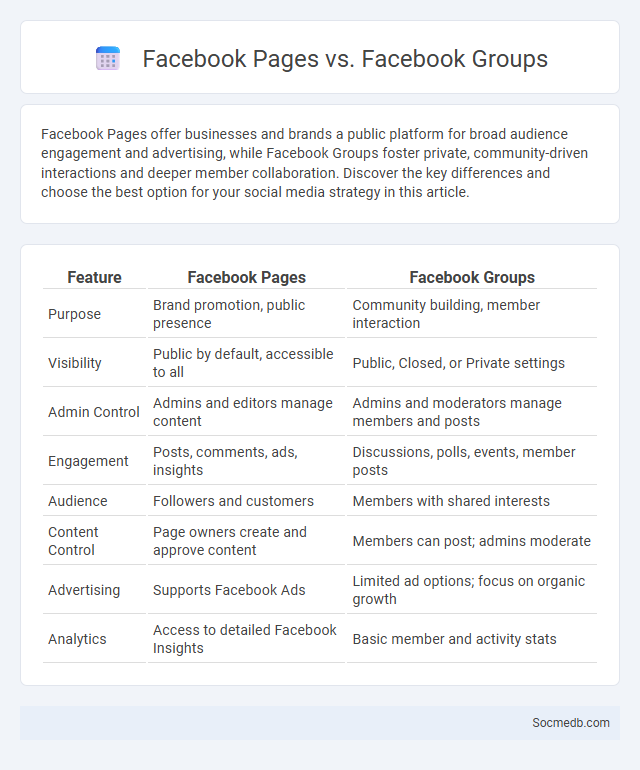
Photo illustration: Facebook Pages vs Facebook Groups
Facebook Pages offer businesses and brands a public platform for broad audience engagement and advertising, while Facebook Groups foster private, community-driven interactions and deeper member collaboration. Discover the key differences and choose the best option for your social media strategy in this article.
Table of Comparison
| Feature | Facebook Pages | Facebook Groups |
|---|---|---|
| Purpose | Brand promotion, public presence | Community building, member interaction |
| Visibility | Public by default, accessible to all | Public, Closed, or Private settings |
| Admin Control | Admins and editors manage content | Admins and moderators manage members and posts |
| Engagement | Posts, comments, ads, insights | Discussions, polls, events, member posts |
| Audience | Followers and customers | Members with shared interests |
| Content Control | Page owners create and approve content | Members can post; admins moderate |
| Advertising | Supports Facebook Ads | Limited ad options; focus on organic growth |
| Analytics | Access to detailed Facebook Insights | Basic member and activity stats |
Understanding Facebook Pages: Purpose and Features
Facebook Pages serve as powerful tools for businesses, brands, and public figures to establish a professional online presence and engage with their audience. Your Facebook Page allows you to share content, promote events, and access detailed analytics to understand user interactions and improve marketing strategies. Features such as call-to-action buttons, messaging, and customizable tabs enhance communication and customer engagement on the platform.
Exploring Facebook Groups: Community and Engagement
Facebook Groups serve as dynamic hubs for fostering community and enhancing user engagement by bringing together people with shared interests. These groups offer tailored spaces for discussions, resource sharing, and networking, driving deeper interaction beyond standard social media posts. Effective group moderation and active participation amplify member connection, boosting overall platform engagement and user retention.
What Is Viral Content on Facebook?
Viral content on Facebook refers to posts, videos, or images that rapidly gain extensive shares, likes, and comments, reaching a vast audience beyond the original followers. This type of content often features emotionally engaging elements, relatable themes, or trending topics that encourage users to interact and spread the material organically. Understanding Facebook's algorithm, which prioritizes content with high engagement rates, is crucial for creating viral posts that maximize visibility and impact.
Key Differences: Pages vs Groups vs Viral Content
Social media Pages serve as official profiles for businesses, celebrities, or brands, facilitating public communication and content broadcasting to a broad audience. Groups enable community interaction by allowing members to share posts, discuss topics, and collaborate within a more private or interest-based environment. Viral content rapidly spreads across networks due to high engagement levels, leveraging shares, likes, and comments to maximize visibility and reach beyond initial followers.
Audience Reach: Which Option Delivers More?
When comparing social media platforms for audience reach, Facebook boasts over 2.9 billion monthly active users, while Instagram, owned by Facebook, has about 2 billion. You reach a broader and more varied demographic on Facebook, making it ideal for campaigns needing extensive visibility. For targeted engagement, Instagram's younger user base and visual focus deliver more concentrated reach among niche markets.
Content Strategies for Pages, Groups, and Viral Posts
Effective content strategies for social media pages involve consistent posting of high-quality, engaging visuals and targeted text that align with audience interests to boost reach and interaction. Creating content for groups requires fostering community-driven discussions and sharing exclusive, valuable information to enhance member loyalty and participation. Viral posts often combine emotional appeal, timely relevance, and shareability factors like humor or controversy to maximize organic spread and user engagement across platforms.
Engagement Metrics: Analyzing Performance
Engagement metrics such as likes, comments, shares, and click-through rates provide critical insights into how your audience interacts with social media content. Analyzing these metrics helps identify the most effective posts, optimal posting times, and audience preferences. Tracking engagement metrics enables you to refine strategies for increased reach and stronger community connections.
Monetization Opportunities: Pages vs Groups
Social media monetization opportunities vary significantly between pages and groups, with pages offering more direct avenues such as sponsored posts, branded content, and ad placements due to their public visibility and follower metrics. Groups foster higher engagement and community trust, enabling indirect monetization through membership fees, exclusive content, and product promotions within niche audiences. Leveraging the strengths of pages for broad reach and groups for targeted interaction maximizes revenue potential across platforms like Facebook, Instagram, and LinkedIn.
Algorithms and Visibility: How Content Spreads
Social media algorithms prioritize content based on user engagement metrics such as likes, shares, comments, and watch time, influencing how widely posts are distributed across platforms like Facebook, Instagram, and TikTok. These algorithms analyze user behavior patterns and preferences to personalize content feeds, maximizing visibility for posts that generate higher interaction rates. Viral content often emerges when algorithms amplify highly engaging or trending posts, enabling rapid and extensive spread across diverse user networks.
Choosing the Right Approach for Your Brand
Selecting the right social media approach involves understanding your target audience and aligning content strategies with brand values to maximize engagement. Analyzing platform demographics and user behavior ensures tailored messaging that resonates effectively across channels such as Instagram, LinkedIn, or TikTok. Leveraging data-driven insights and performance metrics optimizes campaign outcomes, strengthening brand presence and driving meaningful interactions.
 socmedb.com
socmedb.com